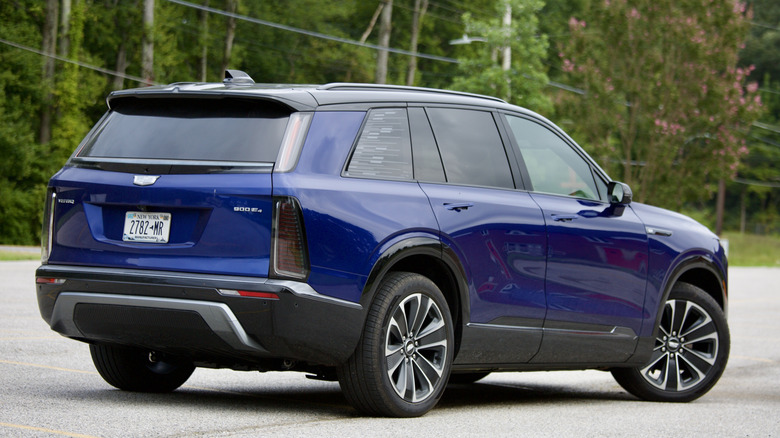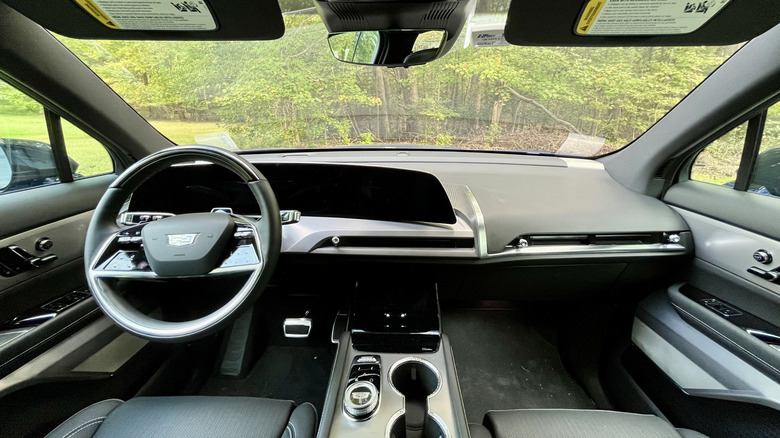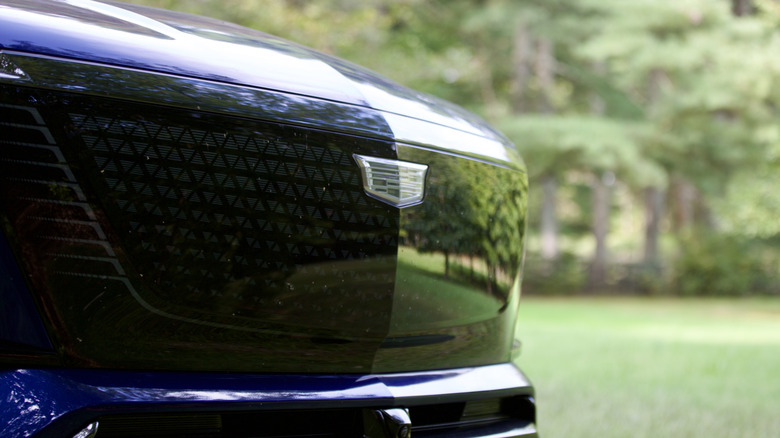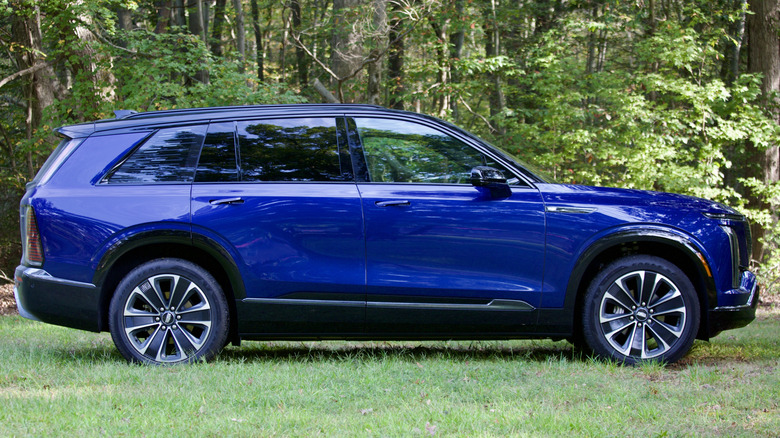The 2026 Cadillac Vistiq Wins Because Nobody Else Showed Up (Yet)
Cadillac's electric offerings are as varied as they are confusing. Starting at the smallest, there's the Optiq, then, the slightly larger Lyriq, the larger still Vistiq, and lastly the gargantuan Escalade IQ. The boutique custom-built Celestiq sedan is also a Cadillac EV, but if you are looking for reviews online before you buy a $300,000+ EV sedan, then you are likely an outlier who operates under a different set of rules and expectations.
After getting a taste for Cadillac EVs earlier in the year with the Optiq, it only made sense to try other Caddys with the newest Vistiq. Unlike the Optiq and Lyriq which relate to the Chevy Equinox EV and Chevy Blazer EV respectively, the three-row Vistiq doesn't have any siblings in the General Motors family. It's kind of its own thing, but size-wise you could relate it to the Chevy Traverse or GMC Acadia if you're looking for a scale comparison.
Categorization aside, I was intrigued when a 2026 Cadillac Vistiq Sport silently rolled into my neighborhood. It was actually the first one I had ever seen in person, I suspect because my review was fairly close to the launch date of the car along with the fact that the Vistiq starts at a very Cadillac-like $79,090. In my neighborhood of CR-Vs, Camrys, Jettas, and Foresters, it stood out like a bright blue thumb.
A big fast electric Caddy
Under the proverbial hood of the Vistiq (you don't get a frunk), are two electric motors that put out a very stout 615 horsepower. Electrons are fed to those motors via a 102 kilowatt-hour battery. Range is listed at an estimated 300 miles, and I found that estimate to be accurate. For such a big battery, 300 miles is adequate, though not outstanding.
Cadillac also estimates the 0-60 time to be 3.7 seconds, which — combined with over 600 horsepower — puts the Vistiq into early 2000s supercar territory. If you would have told me in high school that, in 2025, there would be a tennis-mom Cadillac with more horsepower and a quicker acceleration time than an early Dodge Viper, I would have said you were lying.
As for what it's like to drive, it's everything a Cadillac should be: quiet, sophisticated, and comfortable. Unlike the Escalade V I drove last year, which did demonstrated its horsepower in a way that probably qualifies as a felony in a few states, the Vistiq was more composed. You wouldn't know it had over 600 horsepower unless you stomped the accelerator. It was refined and stately, even a little boring, though that's not really a bad thing. You don't buy a three-row SUV to beat up Mustangs and Chargers at the drag strip, you buy it to move people, things, and animals to where they need to go in comfort and style. For that task, the Vistiq was great.
As a Cadillac should be
In fact, the Vistiq wasn't all that interesting of a car to live with, and I think that's undoubtedly a strength rather than any sort of a weakness, If you want to normalize electric car ownership, the worst thing you can do is make something outlandish and stupid that's going to scare normal people away (cough Cybertruck cough). The Vistiq isn't scary. It's a huge, stylish SUV that fits right in with every other huge, stylish SUV. It just happens to be electric. Plus, the cultural weight behind a Cadillac badge helps with the reputation.
Since it's a Cadillac which runs in excess of $80,000, it's fairly clear that you're going to have a nice time sitting inside. Every surface is covered in leather, or something which does a solid impersonation of it. There's a sunroof that runs the length of the car, and an AKG sound system that ensures whatever fancy classical music or avant-garde jazz you're listening to sounds great. The EV-ness of the Vistiq adds to the experience, because you can't hear anything as low-class and gauche as an engine. There's just a gentle whir when you accelerate, accompanied by the thoughts of your own superiority.
Cadillac's suspension magic is second to none in the industry and, despite the inherent heft of an EV, it glides pretty effortlessly along the road, pretty much ignoring imperfections in the pavement. I really can't think of anything negative to say about how the Vistiq drove, other than it betrays its own horsepower by staying calm the vast majority of the time you're driving. But even that is hardly a complaint.
Pricey and posh
The Vistiq is one of the many current — and future — vehicles from GM's stable to forgo any phone mirroring functionality like Apple CarPlay or Android Auto. I don't like that decision and it's a fairly baffling one to make, but in practice, it's at worst mildly inconvenient. I was able to take calls and control my music and podcasts just fine, all it took was relearning the user interface. That's not all that bad or annoying once you figure it out, it's just a worse system than CarPlay or Android Auto.
The ever-present threat of tariffs and a volatile economy have actually changed the price of the 2026 Vistiq from when I reviewed it barely a month ago, so for disclosure's sake, I will be using the prices currently listed on Cadillac's website as opposed to the Vistiq's window sticker. The starting price of the 2026 Cadillac Vistiq Sport I tested was $79,590. It was painted in "Opulent Blue Metallic" which will set you back $625. The two-tone black roof option is $600, while for $800 you can forgo a 7-seater configuration and turn the middle bench into two captain's chairs for a total of six seats. A destination charge of $1,695 brings the total to $81,615.
The triple row threat
Just by the very fact it has three rows of seating and is a luxury EV, the Vistiq's competition is slim. Within Cadillac, there's the Escalade IQ, but given its starting price of over $127,000, it's not really in the same conversation (you could even make the argument that the Vistiq makes the Escalade IQ irrelevant). Lucid has its excellent Gravity minivan/SUV thing, but once again, the only version currently available is the Grand Touring trim at a hefty $94,900.
The upcoming Gravity Touring will be less expensive, and Genesis is working on its more lavish, GV90 version of the Hyundai Ioniq 9, but there's no expected launch date for either as of yet.
Both the Escalade IQ and Gravity exceed 400 miles of range, but at a cost of tens of thousands of dollars. Is 100 miles or so further between plug-ins worth it? That's up to the buyer, but I argue that the Vistiq is a pretty good place to be. 300 miles with a third row for just over $80,000 puts the Vistiq above a lot of the competition.
2026 Cadillac Vistiq verdict
That price shouldn't scare existing Cadillac customers, as there a several variations of Caddy that can exceed $100,000 without even trying all that hard. The same can be said for BMW and Mercedes. As far as luxury EVs are concerned, the Vistiq is competitive with (and cheaper) than the $89,950 Mercedes EQS. The Merc only offers slightly more range at 317 miles, thanks to its marginally bigger battery, but much less third row space in its optional 7-seat configuration.
The 2026 BMW iX xDrive60 offers a much higher maximum range of an estimated 364 miles and it's more expensive, starting at $88,500. BMW's love of optional extras will likely drive that price higher, and there's no option to add a third row.
Despite costing more than many will ever pay for a car, the Vistiq is arguably a great deal. Would I opt for the Sport trim over the base model? Probably not as the drivetrain is the same, but compared to offerings from the Germans, the big blue American EV is cheaper and offers more power and a quicker acceleration time. Is that the most important metric to consider for your electric family hauler? Not really, but if you're looking for a slight edge over the competition, the Vistiq has it in the bag in the most American way possible.





